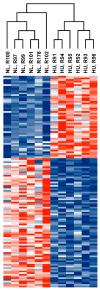Simulated Microgravity Alters Gene Regulation Linked to Immunity and Cardiovascular Disease
- PMID: 39202335
- PMCID: PMC11353732
- DOI: 10.3390/genes15080975
Simulated Microgravity Alters Gene Regulation Linked to Immunity and Cardiovascular Disease
Abstract
Microgravity exposure induces a cephalad fluid shift and an overall reduction in physical activity levels which can lead to cardiovascular deconditioning in the absence of countermeasures. Future spaceflight missions will expose crew to extended periods of microgravity among other stressors, the effects of which on cardiovascular health are not fully known. In this study, we determined cardiac responses to extended microgravity exposure using the rat hindlimb unloading (HU) model. We hypothesized that exposure to prolonged simulated microgravity and subsequent recovery would lead to increased oxidative damage and altered expression of genes involved in the oxidative response. To test this hypothesis, we examined hearts of male (three and nine months of age) and female (3 months of age) Long-Evans rats that underwent HU for various durations up to 90 days and reambulated up to 90 days post-HU. Results indicate sex-dependent changes in oxidative damage marker 8-hydroxydeoxyguanosine (8-OHdG) and antioxidant gene expression in left ventricular tissue. Three-month-old females displayed elevated 8-OHdG levels after 14 days of HU while age-matched males did not. In nine-month-old males, there were no differences in 8-OHdG levels between HU and normally loaded control males at any of the timepoints tested following HU. RNAseq analysis of left ventricular tissue from nine-month-old males after 14 days of HU revealed upregulation of pathways involved in pro-inflammatory signaling, immune cell activation and differential expression of genes associated with cardiovascular disease progression. Taken together, these findings provide a rationale for targeting antioxidant and immune pathways and that sex differences should be taken into account in the development of countermeasures to maintain cardiovascular health in space.
Keywords: cardiovascular system; hindlimb unloading; immune response; microgravity; transcriptomics.
Conflict of interest statement
The authors declare no conflicts of interest.
Figures







Similar articles
-
Previous exposure to simulated microgravity does not exacerbate bone loss during subsequent exposure in the proximal tibia of adult rats.Bone. 2013 Oct;56(2):461-73. doi: 10.1016/j.bone.2013.07.004. Epub 2013 Jul 17. Bone. 2013. PMID: 23871849
-
Simulated microgravity decreases circulating iron in rats: role of inflammation-induced hepcidin upregulation.Exp Physiol. 2017 Mar 1;102(3):291-298. doi: 10.1113/EP086188. Exp Physiol. 2017. PMID: 28087888
-
Effects of low-dose rate γ-irradiation combined with simulated microgravity on markers of oxidative stress, DNA methylation potential, and remodeling in the mouse heart.PLoS One. 2017 Jul 5;12(7):e0180594. doi: 10.1371/journal.pone.0180594. eCollection 2017. PLoS One. 2017. PMID: 28678877 Free PMC article.
-
Hindlimb unloading: rodent analog for microgravity.J Appl Physiol (1985). 2016 May 15;120(10):1196-206. doi: 10.1152/japplphysiol.00997.2015. Epub 2016 Feb 11. J Appl Physiol (1985). 2016. PMID: 26869711 Review.
-
[The progress in research on changes of central venous pressure under simulated weightlessness and microgravity].Space Med Med Eng (Beijing). 1999 Dec;12(6):459-63. Space Med Med Eng (Beijing). 1999. PMID: 12434816 Review. Chinese.
Cited by
-
Oxidative Stress on the Ground and in the Microgravity Environment: Pathophysiological Effects and Treatment.Antioxidants (Basel). 2025 Feb 18;14(2):231. doi: 10.3390/antiox14020231. Antioxidants (Basel). 2025. PMID: 40002415 Free PMC article. Review.
References
-
- Khine H.W., Steding-Ehrenborg K., Hastings J.L., Kowal J., Daniels J.D., Page R.L., Goldberger J.J., Ng J., Adams-Huet B., Bungo M.W., et al. Effects of Prolonged Spaceflight on Atrial Size, Atrial Electrophysiology, and Risk of Atrial Fibrillation. Circ. Arrhythm. Electrophysiol. 2018;11:e005959. doi: 10.1161/CIRCEP.117.005959. - DOI - PubMed
MeSH terms
Grants and funding
LinkOut - more resources
Full Text Sources

